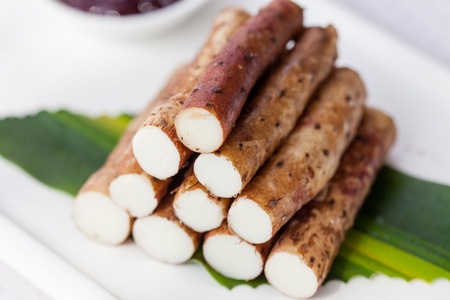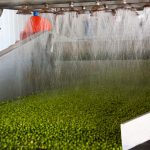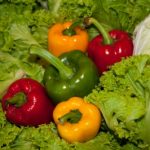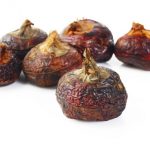
Chinese Yam, also known as Korean Yam (Dioscorea opposite Thunb) has a rhizome which is a regularly consumed food in China with a similarly long association as a traditional Chinese medicine. Like most yams, it is a staple because of its high carbohydrate content as it is with yam cultivation in Africa.
Popular uses and treatments (Zuo and Tang, 2003) for the Chinese yam:
- diabetes
- asthma
- diarrhoea
The major carbohydrate is starch which forms somewhere between 75 to 85 per cent of the total weight. The remainder is what is so interesting.
The important pharmacological components are the polysaccharides, flavonoids, allantoin and allantoic acid (Fu et al., 2006), phenanthrenes (Coxon et al., 1982), choline (Fu et al., 2005), dioscorin (a storage protein), dioscin (Jeon et al., 2006), and quite a number of others. Generally, most interest is now reserved for the polysaccharides and dioscin.
The polysaccharides, especially one called RDPS-1 is probably likely to develop as a potential anti-cancer agent and has been known for some time for these benefits (Zhao et al., 2003). There is also an anti-diabetic activity to be examined further (Gao et al., 2007) with the polysaccharides. These also possess strong gut promoting benefits probably serving as a prebiotic given their effects on endometrial epithelial cells (Ju et al., 2014). This must be borne out by the similar responses these polysaccharides have on the immune system through enhancing of certain cell systems (Kong et al., 2009).
It is also worth looking at the antifungal properties of the phenanthrenes (Coxon et al., 1982). The phenolics too in Chinese Yam can claim attention for their lipase inhibitory action (Yang et al., 2014). Finally, we notice some powerful evidence for the anti-inflammatory benefits of the phenolics especially as an anti-oxidant and in suppressing leukotriene synthesis (and presumably thromboxane production). (Yang et al., 2009).
References
Coxon, D.T., Ogundana, S.K., Dennis, C. (1982) Antifungal phenanthrenes in yam tubers. Phytochemistry 21(6) pp. 1389–92
Fu, Y.-C., Chen, S.H., Huang, P.Y., Li, Y.J. (2005) Application of bubble separation for quantitative analysis of choline in Dioscorea (yam) tubers. J. Agric. Food Chem. 53(7) pp. 2392–8.
Fu, Y.-C., Ferng, L.-H.A., Huang, P.-Y. (2006) Quantitative analysis of allantoin and allantoic acid in yam tuber, mucilage, skin and bulbil of the Dioscorea species. Food Chem. 94(4) pp. 541–9
Gao, X., Li, B., Jiang, H., Liu, F., Xu, D., Liu, Z. (2007) Dioscorea opposita reverses dexamethasone induced insulin resistance. Fitoterapia 78(1) pp. 12–5
Jeon, J.R., Lee, J.S., Lee, C.H., Kim, J.Y., Kim, S.D., Nam, D.H. (2006) Effect of ethanol extract of dried Chinese yam (Dioscorea batatas) flour containing dioscin on gastrointestinal function in rat model. Arch. Pharm. Res. 29(5) pp. 348–53
Ju, Y., Xue, Y., Huang, J., Zhai, Q., Wang, X.H. (2014) Antioxidant Chinese yam polysaccharides and its pro-proliferative effect on endometrial epithelial cells. Intl. J. Biol. Macromol. 66(5) pp. 81–5
Kong, X.F., Zhang, Y.Z., Yin, Y.L., Wu, G.Y., Zhou, H.J., Tan, Z.L., Yang, F., Bo, M.J., Huang, R.L., Li, T.J. (2009) Chinese Yam polysaccharide enhances growth performance and cellular immune response in weanling rats. J. Sci. Food Agric. 89(12) pp. 2039–44
Yang, M.H., Chin, Y.W., Yoon, K.D., Kim, J. (2014) Phenolic compounds with pancreatic lipase inhibitory activity from Korean yam (Dioscorea opposita). J. Enzyme Inhibition Med. Chem. 29(1) pp. 1–6.
Yang, M.H., Yoon, K.D., Chin, Y.W., Park, J.H., Kim, J. (2009) Phenolic compounds with radical scavenging and cyclooxygenase-2 (COX-2) inhibitory activities from Dioscorea opposita. Bioorg. Med Chem. 17(7) pp. 2689–94.
Zhao, G., Li, Z., Chen, Z. (2003) Structural analysis and antitumor activity of RDPS-I polysaccharide from Chinese yam. Acta Pharm. Sinca 38(1) pp. 37–41.
Zuo, Y., Tang, D. (2003) Science of Chinese Materia Medca. Shangai University of Traditional Chinese Medicine Press. pp. 301–3.



Leave a Reply